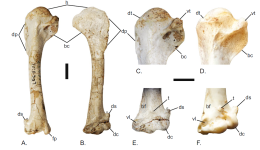Fred Ruhe
Well-known member

Thomas A. Stidham, Jingmai O'Connor & Zhiheng Li, 2023
The Pleistocene Zhoukoudian ‘Peking Man’ site records the first Beijing (China) evidence of the Northern Raven (Corvus corax)
Journal of Ornithology
Abstract: The Pleistocene Zhoukoudian ‘Peking Man’ site records the first Beijing (China) evidence of the Northern Raven (Corvus corax) - Journal of Ornithology
Study of the holotype and only known material of the purportedly extinct corvid species ‘Corvus fangshannus’ from the late Middle or Late Pleistocene locality 3 of the UNESCO Zhoukoudian ‘Peking Man’ site in Beijing, China, documents its identification instead as a member of the sedentary Northern Raven (Corvus corax) lineage. Shared features of the humerus including those consistent with species of Corvus (protruding ventral tubercle and rounded and not prominent bicipital crest) and a combination of features (including overall size and the presence of a concave ventral margin where the ventral supracondylar tubercle projects ventral to the diaphysis) help to support the allocation of this Pleistocene material to that particular species’ lineage. Ravens do not occur historically within the Beijing Municipality, and this reidentified fossil is the first record from the area. When considered alongside a similar extralimital record based on a recently reported Middle Pleistocene raven skull from Liaoning Province, these fossils together may indicate that the Northern Raven’s prehistoric geographic distribution in northeastern China encompassed a broader area south of its current distribution extending to ~ 40–41 degrees latitude. Changes to the raven’s geographic distribution likely are linked to shifts between cooler and drier climates and warmer ones, along with their interactions with extinct non-analogous vertebrate communities of the Pleistocene. These ravens would have scavenged alongside hyenas, other large mammalian carnivores, and even early humans in northern China.
Enjoy,
Fred
The Pleistocene Zhoukoudian ‘Peking Man’ site records the first Beijing (China) evidence of the Northern Raven (Corvus corax)
Journal of Ornithology
Abstract: The Pleistocene Zhoukoudian ‘Peking Man’ site records the first Beijing (China) evidence of the Northern Raven (Corvus corax) - Journal of Ornithology
Study of the holotype and only known material of the purportedly extinct corvid species ‘Corvus fangshannus’ from the late Middle or Late Pleistocene locality 3 of the UNESCO Zhoukoudian ‘Peking Man’ site in Beijing, China, documents its identification instead as a member of the sedentary Northern Raven (Corvus corax) lineage. Shared features of the humerus including those consistent with species of Corvus (protruding ventral tubercle and rounded and not prominent bicipital crest) and a combination of features (including overall size and the presence of a concave ventral margin where the ventral supracondylar tubercle projects ventral to the diaphysis) help to support the allocation of this Pleistocene material to that particular species’ lineage. Ravens do not occur historically within the Beijing Municipality, and this reidentified fossil is the first record from the area. When considered alongside a similar extralimital record based on a recently reported Middle Pleistocene raven skull from Liaoning Province, these fossils together may indicate that the Northern Raven’s prehistoric geographic distribution in northeastern China encompassed a broader area south of its current distribution extending to ~ 40–41 degrees latitude. Changes to the raven’s geographic distribution likely are linked to shifts between cooler and drier climates and warmer ones, along with their interactions with extinct non-analogous vertebrate communities of the Pleistocene. These ravens would have scavenged alongside hyenas, other large mammalian carnivores, and even early humans in northern China.
Enjoy,
Fred
Last edited:




